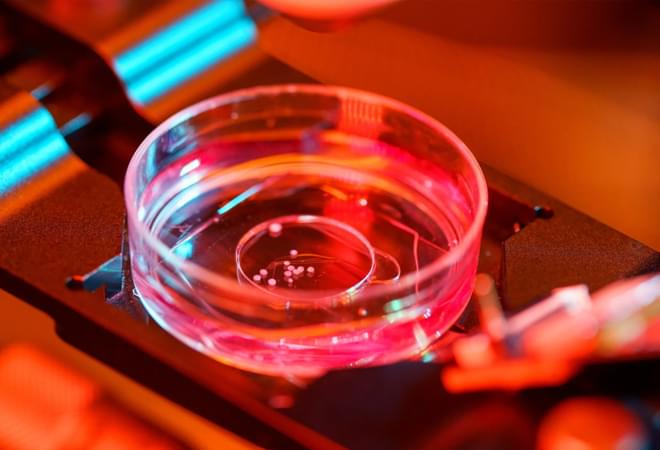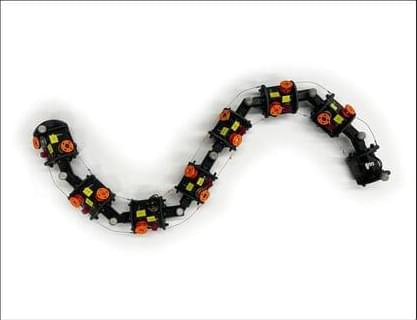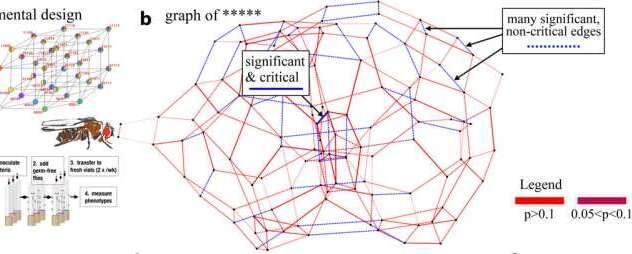The advantages of biological learning make OI a tempting notion to embrace, however, there are significant ethical and technological hurdles to overcome before we develop an OI biocomputer.



To advance our overall understanding and discover principles of mechanical intelligence in limbless locomotion and to understand the potential role of bilateral actuation specifically in mechanical control, we took a comparative biological and robophysical approach using two complementary models: a biological model, the nematode C. elegans, and a robophysical model, a limbless robot incorporating a bilateral actuation scheme that permits programmable, dynamic, and quantifiable body compliance (Fig. 1B). This compliance governs the passive body-environment interactions in the horizontal plane that allow mechanical intelligence. Because separating neural and mechanical aspects of control is challenging in a freely locomoting living system, we used the robot as a model (22, 24, 49, 50) that then allowed mechanical intelligence to be isolated from active controls and to be systematically tuned and tested.
Using comparisons between the kinematics and locomotor performance of our biological and robophysical models, we show that mechanical intelligence alone is sufficient for an open-loop limbless robot to reproduce locomotory behavior of nematodes. Mechanical intelligence simplifies controls in terrestrial limbless locomotion by taking advantage of passive body-environment interactions that enable heterogeneity negotiation, thereby stabilizing locomotion. Further, we show that a simple active behavior inspired by nematodes takes advantage of mechanical intelligence to enhance locomotion performance even further. Our method and results not only provide insight into the functional mechanism of mechanical intelligence in organismal limbless locomotion but also provide an alternative paradigm for limbless robot development that simplifies control in complex environments.

A team of researchers around Berlin mathematics professor Michael Joswig is presenting a novel concept for the mathematical modeling of genetic interactions in biological systems. Collaborating with biologists from ETH Zurich and Carnegy Science (U.S.), the team has successfully identified master regulators within the context of an entire genetic network.
The research results provide a coherent theoretical framework for analyzing biological networks and have been published in the Proceedings of the National Academy of Sciences.
It is a longstanding goal of biologists to determine the key genes and species that have a decisive impact on evolution, ecology, and health. Researchers have now succeeded in identifying certain genes as master regulators in biological networks. These key regulators exert greater control within the system and steer essential cellular processes. Previous studies have mainly focused on pairwise interactions within the system, which can be strongly affected by genetic background or biological context.

A supercomputer scheduled to go online in April 2024 will rival the estimated rate of operations in the human brain, according to researchers in Australia. The machine, called DeepSouth, is capable of performing 228 trillion operations per second.
It’s the world’s first supercomputer capable of simulating networks of neurons and synapses (key biological structures that make up our nervous system) at the scale of the human brain.
DeepSouth belongs to an approach known as neuromorphic computing, which aims to mimic the biological processes of the human brain. It will be run from the International Center for Neuromorphic Systems at Western Sydney University.



Growing old may come with more aches and pains attached, but new research suggests there’s a bigger picture to look at: by reaching our dotage, we might actually be helping the evolution of our species.
Once assumed to be an inevitable consequence of living in a rough-and-tumble world, aging is now considered something of a mystery. Some species barely age at all, for example. One of the big questions is whether aging is simply a by-product of biology, or something that comes with an evolutionary advantage.
The new research is based on a computer model developed by a team from the HUN-REN Centre for Ecological Research in Hungary which suggests old age can be positively selected for in the same way as other traits.
In this episode of the Smarter Not Harder Podcast, our guest Alex Rosenberg joins our host Boomer Anderson to give one-cent solutions to life’s $64,000 questions that include:\
\
What are the definitions of scientism and naturalism?\
Is there such a thing as free will, and if so, what implications does it have on the search for purpose in life?\
What is nice nihilism?\
\
Alex Rosenberg is an American philosopher and novelist. He is the R. Taylor Cole Professor of Philosophy at Duke University, and is well known for contributions in the philosophy of biology, as well as the philosophy of economics. He has also written several books, including \.

Prehistoric insects, with their delicate and soft bodies, are challenging to preserve as fossils. While wings are more commonly fossilized, the bodies of these insects are often fragmented or incomplete, posing difficulties for scientific study. Paleontologists often rely on trace fossils to learn about these ancient insects, which are almost exclusively found as traces on fossil plants.
“We have a great fossil plant record,” said Richard J. Knecht, a Ph.D. candidate in the Department of Organismic and Evolutionary Biology at Harvard. “Further back in time, it’s the trace fossils that tell us more about the evolution and behavior of insects than the body fossils because plants and the trace fossils on them preserve very well. And the trace, as opposed to a body, won’t move over time and is always found where it was made.”

ICYMI: DeepSouth uses a #neuromorphiccomputing system which mimics biological processes, using hardware to efficiently emulate large networks of spiking #neurons at 228 trillion #Synaptic operations per second — rivalling the estimated rate of operations in the human brain.
Australian researchers are putting together a supercomputer designed to emulate the world’s most efficient learning machine – a neuromorphic monster capable of the same estimated 228 trillion synaptic operations per second that human brains handle.
As the age of AI dawns upon us, it’s clear that this wild technological leap is one of the most significant in the planet’s history, and will very soon be deeply embedded in every part of our lives. But it all relies on absolutely gargantuan amounts of computing power. Indeed, on current trends, the AI servers NVIDIA sells alone will likely be consuming more energy annually than many small countries. In a world desperately trying to decarbonize, that kind of energy load is a massive drag.
But as often happens, nature has already solved this problem. Our own necktop computers are still the state of the art, capable of learning super quickly from small amounts of messy, noisy data, or processing the equivalent of a billion billion mathematical operations every second – while consuming a paltry 20 watts of energy.